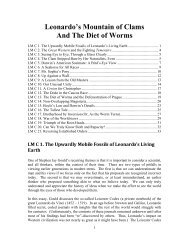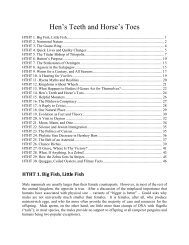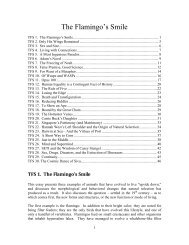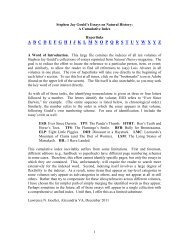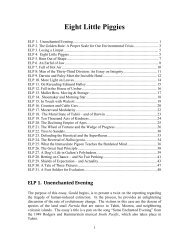things male, while the beautiful is all things female. “Sublime” refers to the concepts ofwide-open spaces, stalking and killing prey, and danger, and is in essence about selfpreservation.“Beautiful,” on the other hand, incorporates the concepts of fragility,delicacy, bright colors, smoothness of shape, and is in essence about procreation. Theimportance of Burke’s essay, Gould states, is that it captures the deep and profoundsexism of the era, and we must know the roots of oppression in order to combat iteffectively. He identifies several examples in Robert’s book of what, in context, can berecognized as Burke’s beautiful, and not a hint of sublime.It proved very difficult for Gould to learn more about Mary Roberts, other than her datesof birth and death, the fact that she never married, and a list of the books she authored.This is consistent with the theme of metaphorical invisibility that these womenexperienced. But he did track down another of her books, this one of a different genre,called The Progress of Creation. As if to emphasize just how full of twists and turns theworld is, Gould found himself actually angered by this book. It takes a hard line oncreationism, including a literal interpretation of six days of 24 hours. By the time thisbook was published in 1846, this view had been completely rejected by the scientificcommunity. She takes insulting shots at many of the leading (male) scientists of the timefor expressing even the possibility that Noah’s flood was only the latest in a series ofcatastrophes, and makes defiant claims for which there was contradictory evidenceavailable at the time. This book was pure nonsense, Gould concludes – but it wassublime nonsense!DIH 16. Left Snails and Right Minds<strong>In</strong> this unusual essay, Gould discovers a mystery about snail documentation, but is unableto resolve it. The mystery does not directly involve nature, but rather the visualrepresentation of snails in the plates of books before the mid-18 th century.Snail shells are one of the few macroscopic organic structures that do not exhibit bilateralsymmetry; they are twisted. This twisting can take on one of two orientations, commonlyreferred to as dextral (right-handed) and sinistral (left-handed). Normal screw threads aredextral. Gould posits that one might expect the number of dextral and sinistral shells tobe about the same, but this is not the case: almost all snail shells are dextral, although theoccasional exception has been found in most species. However, the mystery of this essayis not why the fraction is other than 50-50 [or, although Gould does not raise thisquestion, 100% – 0%]; the mystery is why virtually all books before about 1750 showsnails as sinistral, while books after this date portray them in the more accurate dextralorientation. Gould, as a snail man, is sensitive to this issue because he has publishedpapers where the photographic images have been printed with the negative turned over.This leads to dextral snails appearing sinistral (and vice versa), a source of low-leveldishonor in his professional community. However, the figures he addresses here couldnot have been reversed like this, for they were all carved into wood or etched into copper.Since such etchings must be “mirror image” in all cases to make the print come outcorrectly, the next hypothesis might be that snail shells were a place where artisans could“skimp” and carve directly without anyone noticing. Gould considers this unlikely, since22
drawing backwards would have to be second nature to engraving professionals. He alsoconsidered and rejected the hypothesis that the advent of photography forced these artiststo draw snails the normal orientation; there is a century between 1750 (when the snailsappear dextral) and photography’s introduction. Gould concludes that it must have beena formal convention of some sort, although why he has no idea what or why. He asks forhelp on this from his readers, and from antiquarian book dealers. <strong>In</strong> an epilogue, hethanks the many people who offered ideas, but reports that none to date had discoveredthe solution.DIH 17. DinomaniaGould was fascinated by dinosaurs in elementary school, while most of his classmateswere not. After recapitulating some childhood slights regarding this discrepancy ofvalues, he poses a question: why do these same creatures periodically capture the world’simagination in a fad-like way [a theme he also explored in BFB 6]? The specificmotivation in writing this essay was the phenomenal success of <strong>Stephen</strong> Spielberg’smovie Jurassic Park, based on the best-selling novel by Michael Crichton. [This essayoriginally appeared in the New York Review of Books on August 12, 1993, rather than hismonthly column. Gould reviewed both Crichton’s novel and the book The Making ofJurassic Park (about the movie) by Don Shay and Judy Duncan.] Gould expresses thehope that this round of dinomania is based on their recently-improved reputation,stemming from discoveries suggesting that, as a group, dinosaurs were not slow andstupid, and did not become extinct because they could not compete with mammals.Whether the seed of this feedback-driven enterprise was a brilliant marketing executive,or an innate reaction to our fascination with the “big, fierce, and extinct,” he does notknow.He critiques the book and the movie, from the perspectives of both a professionalscientist and a lifelong fan of dinosaur movies. He identifies certain factual errors: mostof the dinosaurs that appear in both media lived during the Cretaceous and not theJurassic, for example, and that most Velociraptors were smaller than the stars of the bookand film. He generally liked the book, but was a bit disappointed with the movie(although he did love the dinosaur scenes themselves). He could easily identify severalpopular “trends” within the professional community, such as the views that dinosaurswere warm-blooded and lived in herds. He appreciated the mechanism of using ancientblood-sucking insects trapped in amber as a source of dinosaur DNA, although he thendiscusses at some length why this would not work in practice. He emphasizes that theproposed technique of filling in the genetic gaps with frog DNA is “their worst scientificblunder.” He appreciated Crichton’s use of chaos theory in the book (life is verycomplex, and will behave in unpredictable ways) as an explanation for how the dinosaursget loose and wreak havoc. <strong>In</strong> the movie version, Gould is irritated that the chaos-theoryversedmathematician quickly defaults to the old chestnut about humans playing God asthe source of the inevitable drama.Gould closes with a discussion of the early scene in which the creator of the park enticesa “big name” paleontologist to visit and recommend his facility. The scientist has no23
- Page 4 and 5: cloud (“nebula”) of gas and dus
- Page 6 and 7: goodness, and is both intelligent a
- Page 9: The second news story involves the
- Page 12 and 13: key ways. Prior to 1994, no fossil
- Page 14: DIH 11. Lucy on the Earth in Stasis
- Page 17: directly resulted in a mass extinct
- Page 20 and 21: Edgar Allan Poe, it turns out, wrot
- Page 24 and 25: interest, until the entrepreneur of
- Page 26 and 27: essay is that scientists, for all t
- Page 28 and 29: DIH 23. The Smoking Gun of Eugenics
- Page 30 and 31: half-Jewish meant Jewish, while qua
- Page 32 and 33: Darwin’s theory, like Adam Smith
- Page 34 and 35: What might a better definition of t
- Page 36 and 37: type of soil, amount of rain, and s
- Page 38 and 39: Case Four, in Gould’s words, is
- Page 40 and 41: multiplying his findings by the num
- Page 42 and 43: other departments, something that r
- Page 44 and 45: Linnaeus, Gould states, did not sim
- Page 46: greatly prefers these metaphors, on




